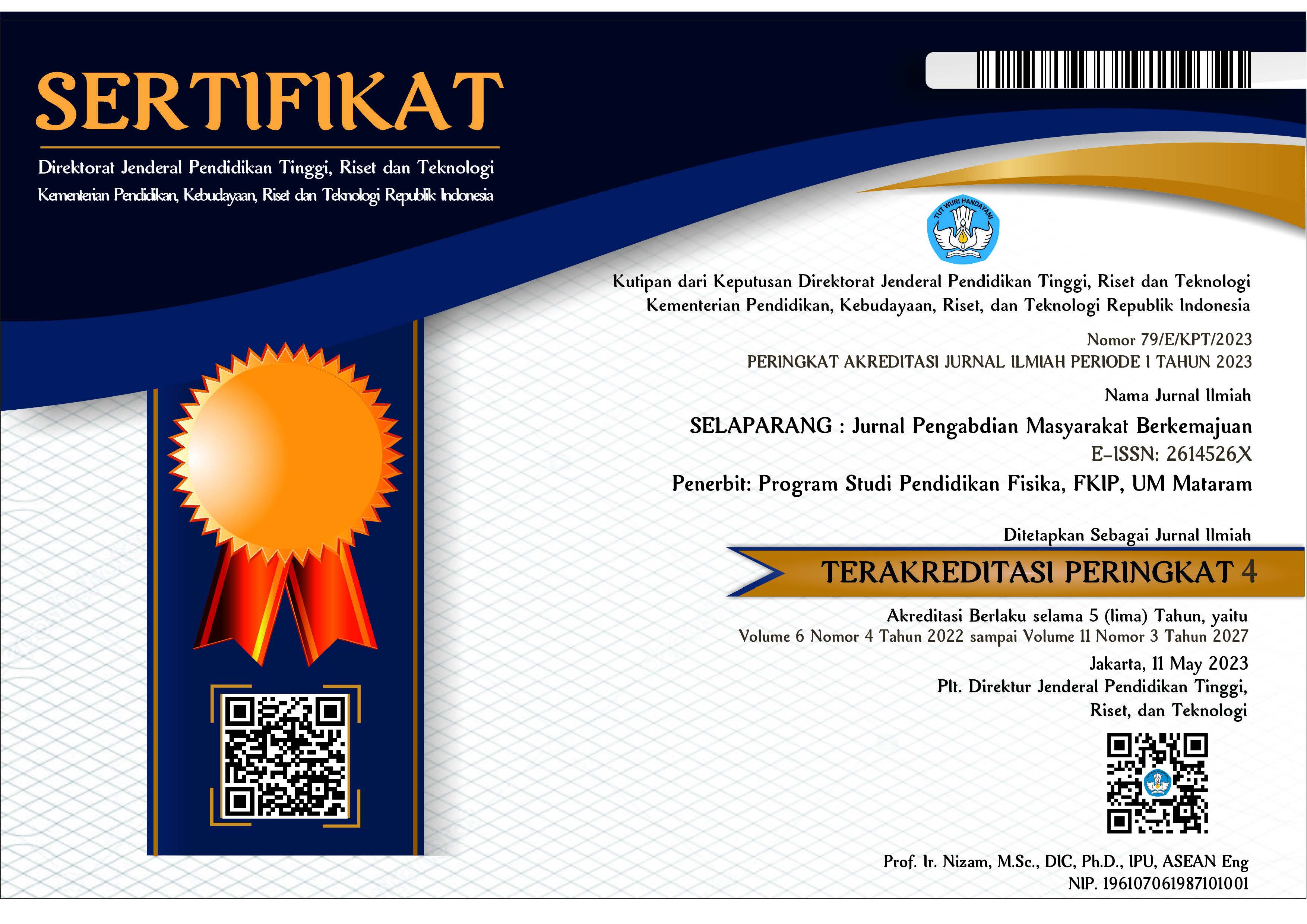Pelatihan pengolahan limbah kopi sebagai kombucha cascara
Abstract
Abstrak
Kopi merupakan salah satu komoditas yang berperanan penting didalam sektor perkebunan Indonesia. Produksi kopi Bondowoso pada tahun 2023 adalah sebesar 10420 ton, jumlah produksi kopi terbesar ketiga di Jawa Timur setelah Malang dan Banyuwangi. Desa Curahpoh merupakan salah satu daerah penghasil kopi robusta dan arabika yang terletak di kaki Gunung Argopuro, Kecamatan Curahdami, Kabupaten Bondowoso, Provinsi Jawa Timur. Saat ini petani Desa Curahpoh yang tergabung didalam kelompok Tani LMDH Argo Santoso telah membudidaya kopi sebagai salah satu mata pencaharian yang potensial. Namun adanya kegiatan budidaya dan pengolahan pasca panen kopi menghasilkan limbah berupa kulit kopi yang dapat menyebabkan polusi dan kerusakan lingkungan. Limbah kulit kopi dapat diolah lebih lanjut sehingga bernilai lebih tinggi. Program ini bertujuan untuk melatih masyarakat Desa Curahpoh untuk mengolah limbah kulit kopi menjadi kombucha cascara. Peserta yang mengikuti kegiatan ini sebanyak 20 orang. Program ini dilaksanakan melalui tahap pelatihan, praktek dan evaluasi. Hasil program menunjukkan bahwa peserta mampu menguasai teknik pembuatan kombucha cascara. Bahkan peserta melakukan inovasi dan sosialisasi produk kombucha cascara kepada masyarakat lebih luas.
Kata kunci: cascara; curahpoh; kombucha; kopi; limbah
Abstract
Coffee is a commodity that plays an important role in the Indonesian plantation sector. Bondowoso coffee production in 2023 will be 10,420 tons, the third largest amount of coffee production in East Java after Malang and Banyuwangi. Curahpoh Village is one of the robusta and arabica coffee producing areas located at the foot of Mount Argopuro, Curahdami District, Bondowoso Regency, East Java Province. Currently, Curahpoh Village farmers who are members of the LMDH Argo Santoso Farmers group have cultivated coffee as a potential source of income. However, coffee cultivation and post-harvest processing activities produce waste in the form of coffee skins which can cause pollution and environmental damage. Coffee skin waste can be processed further so that it has higher value. This program aims to train the people of Curahpoh Village to process coffee skin waste into kombucha cascara. There were 20 participants who took part in this activity. This program is implemented through training, practice and evaluation stages. The program results showed that participants were able to master the technique of making kombucha cascara. Participants even innovated and socialized cascara kombucha products to the wider community.
Keywords: cascara; coffee; curahpoh; kombucha; waste
Keywords
Full Text:
PDFReferences
Ariva, A. N., Widyasanti, A., & Nurjanah, S. (2020). The Effect of Drying Temperature to The Quality of Cascara Tea. Jurnal Teknologi Dan Industri Pertanian Indonesia, 11(01), 21–28.
Arpi, N., Muzaifa, M., Andini, R., Widayat, H. P., Nilda, C., & Nisa, F. (2023). Physicochemical and sensory characteristics of cascara syrup with the addition of lemon ( Citrus limon) extract. IOP Conference Series: Earth and Environmental Science, 1177(1). https://doi.org/10.1088/1755-1315/1177/1/012028
Azizah, A. N., Cahya, G., Darma, E., & Darusman, F. (2020). Formulasi SCOBY (Symbiotic Culture ef Bacteria and Yeast) dari Raw Kombucha Berdasarkan Perbandingan Media Pertumbuhan Larutan Gula dan Larutan Teh Gula. Prosiding Farmasi, 6(2), 325–331.
Badan Pusat Statistik. (2021). Statistik Kopi Indonesia 2020.
Badan Pusat Statistik. (2022). Statistik Kopi Indonesia 2021.
Badan Pusat Statistik. (2023). Statistik Kopi Indonesia 2022 (Vol. 7).
Badan Pusat Statistik Jawa Timur. (2022). Produksi Perkebunan Karet dan Kopi Menurut Kabupaten/Kota dan Jenis Tanaman di Provinsi Jawa Timur (Ton), 2021 dan 2022.
Brilliantina, A., Wibisono, Y., Sari, E. K. N., Adhamatika, A., Triardianto, D., Prayitno, P., & Arifiana, N. B. (2023). Potensi Pupuk Organik Cair Limbah Kulit Kopi Robusta (Coffea canephora L.) di Perumda Perkebunan Kahyangan Jember. Oryza ( Jurnal Pendidikan Biologi ), 12(1), 24–28. https://doi.org/10.33627/oz.v12i1.1047
Cangussu, L. B., Melo, J. C., Franca, A. S., & Oliveira, L. S. (2021). Chemical characterization of coffee husks, a by-product of coffea arabica production. Foods, 10(12), 1–18. https://doi.org/10.3390/foods10123125
Fadilah Azzahra, R. (2021). Review Artikel Produksi Bioetanol Berbahan Dasar Limbah Kulit Kopi Sebagai Bahan Bakar Alternatif. Jurnal Kinetika, 12(02), 58–63.
Ferreira de Miranda, J., Martins Pereira Belo, G., Silva de Lima, L., Alencar Silva, K., Matsue Uekane, T., Gonçalves Martins Gonzalez, A., … Ribeiro Lima, A. (2023). Arabic coffee infusion based kombucha: Characterization and biological activity during fermentation, and in vivo toxicity. Food Chemistry, 412, 135556. https://doi.org/10.1016/j.foodchem.2023.135556
Firdaus, S., Anissa, I., Livia, I., & Siti, A. (2020). “Review” Teh Kombucha Sebagai Minuman Fungsional dengan Berbagai Bahan Dasar Teh. Prosding Seminar Nasional Unimus, 3(2013), 715–730.
Fitriani, F., Arifin, B., & Ismono, H. (2021). Indonesian coffee exports and its relation to global market integration. Journal of Socioeconomics and Development, 4(1), 120. https://doi.org/10.31328/jsed.v4i1.2115
Indra Wardhana, D., Ruriani, E., & Nafi, A. (2019). Karakteristik Kulit Kopi Robusta Hasil samping Pengolahan Metode Kering dari Perkebunan Kopi Rakyat di Jawa Timur. Agritrop, 17(2), 220–229.
Jaramillo, H. Y., Vasco-Echeverri, O., & Camperos, J. A. G. (2023). Characterization of the Coffee Husk: A Potential Alternative for Sustainable Construction. Civil Engineering and Architecture, 11(4), 1902–1908. https://doi.org/10.13189/cea.2023.110418
Jildeh, Z. B., Wagner, P. H., & Schöning, M. J. (2021, July). Sterilization of Objects, Products, and Packaging Surfaces and Their Characterization in Different Fields of Industry: The Status in 2020. Physica Status Solidi (A) Applications and Materials Science, Vol. 218. John Wiley and Sons Inc. https://doi.org/10.1002/pssa.202000732
Mahendra, I. G. A., Wiswata, I. G. N. A., & Ariati, P. E. P. (2020). Pertumbuhan Dan Hasil Tanaman Sawi (Brassica Juncea L.) Yang Di Pupuk Dengan Pupuk Organik Cair Pada Media Tanam Hidroponik. Fakultas Pertanian, 10(20), 29–36.
Maria Sirangelo, T. (2019). Sensory Descriptive Evaluation of Food Products: A Review. Journal of Food Science and Nutrition Research, 02(04), 354–363. https://doi.org/10.26502/jfsnr.2642-11000034
Meifira, A., Fadilah, N., Oktariana, T. I., Jati, D. R., & Apriani, I. (2021). Potensi Penerapan Teknologi Bersih Dan Minimasi Limbah Pada Industri Kopi Purnama. Jurnal Teknologi Lingkungan Lahan Basah, 8(2), 091. https://doi.org/10.26418/jtllb.v8i2.44199
Muzaifa, M., Abubakar, Y., Sulaiman, M. I., Rahmi, F., Andini, R., Teknologi, J., … Hasan, T. (2022). Pengenalan Produk Inovasi Pengolahan Limbah Biji Kopi Melalui Proses Fermentasi Menjadi Minuman Kesehatan ‘ Kombucha Cascara .’ 1(2), 12–16.
Nguyen, D. Van, Duong, C. T. T., Vu, C. N. M., Nguyen, H. M., Pham, T. T., Tran-Thuy, T. M., & Nguyen, L. Q. (2023). Data on chemical composition of coffee husks and lignin microparticles as their extracted product. Data in Brief, 51, 109781. https://doi.org/10.1016/j.dib.2023.109781
Nurhayati, N., Yuwanti, S., & Urbahillah, A. (2020). Physicochemical and Sensory Characteristics of the Cascara (Dried Cherries Coffee Peels) Kombucha. Jurnal Teknologi Dan Industri Pangan, 31(1), 38–49. https://doi.org/10.6066/jtip.2020.31.1.38
Rahmadani, S., Cahya, G., Darma, E., & Darusman, F. (2021). Karakterisasi Fisik Scoby (Symbiotic Culture Of Bacteria And Yeast) Teh Hitam dalam Menyerap Eksudat Luka. Prosidind Farmasi, 7(2), 292–299.
Riga, R., Sari, T. K., Agustina, D., Fitri, B. Y., Ikhsan, M. H., Pratama, F. H., & Oktria, W. (2022). Pembuatan Pupuk Kompos Dari Limbah Kulit Kopi Di Daerah Penghasil Kopi Nagari Koto Tuo , Sumatera Barat. Jurnal Pengabdian Pada Masyarakat, 7(3), 584–591. https://doi.org/10.30653/002.202273.145
Riswanto, D., & Rezaldi, F. (2021). Kombucha Tea: a Study on the Halal of Fermented Drinks. International Journal Mathla’ul Anwar of Halal Issues, 1(2), 71–77. https://doi.org/10.30653/ijma.202112.28
Rohaya, S., Multahadi, & Sulaiman, I. (2022). Improving the quality of kombucha cascara with different varieties and fermentation time in diverse arabica coffee (Coffea arabica L) cultivars. Coffee Science, 17. https://doi.org/10.25186/.v17i.2056
Setiyono, S., Arum, A. P., SM, S. B. P., Savitri, D. A., Andrean, F. F., & Putri, Z. S. (2023). Pelatihan Pengolahan Limbah Kopi Sebagai Teh Cascara Dan Produk Kerajinan. JMM (Jurnal Masyarakat Mandiri), 7(1), 607. https://doi.org/10.31764/jmm.v7i1.12403
Su, J., Tan, Q., Wu, S., Abbas, B., & Yang, M. (2023). Application of Kombucha Fermentation Broth for Antibacterial, Antioxidant, and Anti-Inflammatory Processes. International Journal of Molecular Sciences, 24(1398). https://doi.org/10.3390/ijms241813984
Subroto, G., & Soejono, D. (2022). Making Bioethanol in Sukorejo Village , Sumber Wringin District Bondowoso Regency. 16(1), 58–74. https://doi.org/10.19184/wrtp.v16i1.
Wyrwa, J., & Barska, A. (2017). Packaging as a Source of Information about Food Products. Procedia Engineering, 182, 770–779. https://doi.org/10.1016/j.proeng.2017.03.199
Yoo, J. H. (2018). Review of disinfection and sterilization - Back to the basics. Infection and Chemotherapy, 50(2), 101–109. https://doi.org/10.3947/ic.2018.50.2.101
DOI: https://doi.org/10.31764/jpmb.v8i1.22022
Refbacks
- There are currently no refbacks.

This work is licensed under a Creative Commons Attribution-ShareAlike 4.0 International License.
______________________________________________________
Jurnal Selaparang
p-ISSN 2614-5251 || e-ISSN 2614-526X
EDITORIAL OFFICE:



















